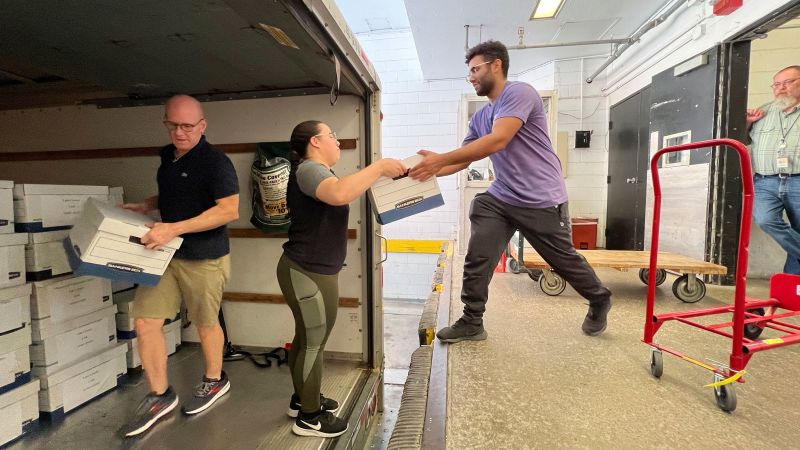Ohio is poised to become the next major abortion battleground after groups seeking to enshrine abortion rights in the state’s constitution on Wednesday submitted hundreds of thousands of petition signatures to the secretary of state’s office.
If certified, those 710,000 signatures – nearly 300,000 more than state law requires – would place the proposed amendment on ballots in November alongside municipal and school board elections across the state.
The statewide vote would come the year after two of Ohio’s neighboring states – deep-red Kentucky and the political battleground of Michigan – supported abortion rights in their own ballot measures.
It would position Ohio, traditionally a presidential swing state that has shifted in the GOP’s favor in recent years, as the latest test of voters’ attitudes ahead of a 2024 presidential election in which the debate over abortion rights could play a central role in both the Republican primary and the general election.
“We know that Ohioans, just like our neighbors in Michigan and Kentucky – when they have the opportunity to vote for abortion access, they will,” said Lauren Blauvelt, vice president of Planned Parenthood Advocates of Ohio.
Abortion rights advocates on Wednesday said they were pulled into politics in the wake of the US Supreme Court’s decision last June to overturn Roe v. Wade’s long-standing federal abortion protections and return the issue to the states.
“I was never very political before all this started last year,” said Dr. Aziza Wahby, a Cleveland dermatologist who has become active over the last year with Ohio Physicians for Reproductive Rights, a group that was part of the effort to gather signatures. “This has made me pay more attention and I think it will do the same for others.”
The proposed amendment in Ohio would ensure “every individual has a right to make and carry out one’s reproductive decisions.” It could make Ohio the only state with a ballot measure on abortion rights this year.
Local officials have until July 20 to verify the signatures, with Ohio Secretary of State Frank LaRose having final approval to place the issue on this fall’s ballots by July 25.
Before the November election, though, is another key vote: an August 8 special election set by Ohio’s Republican-dominated legislature, in which voters will decide whether to raise the threshold for amending the state constitution from the current simple majority to 60%.
The debate over the constitutional amendment and the change to the amendment process has galvanized both sides of the abortion fight.
After filing U-Haul truckloads of petition signatures Wednesday, abortion rights advocates complained that the special election was slated for a moment when families will be wrapping up summer vacations and preparing for the start of school – a period when the state’s voters are not used to casting ballots.
“And they’re doing that on purpose because they know that their agenda is not the agenda of Ohioans,” said Kellie Copeland, the executive director of Pro-Choice Ohio.
Amy Fogel, who said she became awakened to politics during the Trump era and joined the grassroots group Red Wine and Blue, has spent months helping collect signatures for the citizen-led initiative for the November ballot. She said she was “absolutely heartbroken” when the August special election was approved by the Republican supermajority in the statehouse.
“It was just a blatant power grab to take away the majority vote of Ohioans,” Fogel said.
She said she and other volunteers would not be deterred by the new hurdle.
“We started out telling people to vote in November and now we have to tell them to make sure you plan an absentee ballot, vote early, or show up at the polls on August 8,” Fogel said. “You have to vote ‘No,’ to protect the Ohio constitution and majority vote in August and then ‘Yes,’ in November.”
It is confusing, she said, by design.
Amy Natoce, the press secretary for Protect Women Ohio, the coalition working to defeat the abortion rights ballot measure in November, dismissed suggestions that a special election in August was in any way undemocratic because of concerns over historically low voter turnout in the summer.
“There is no time like the present to protect Ohio’s constitution,” Natoce said in an interview. “Ohioans should be reminded of the fact that this is allowing them to determine how their constitution is amended. We’ve seen the other side saying one person, one vote, this takes away the people’s vote. Not at all.”
For the next month, both campaigns will be unfolding across Ohio – on “Issue 1,” to raise the threshold of support needed to change the constitution, and on the November ballot measure on abortion. From door-to-door canvassing to a multi-million dollar television ad campaign, both sides are intensifying their efforts ahead of the August and November elections.
“We’re going to continue in all 88 counties across Ohio,” Natoce said. “But we have to move ahead as if it will be on the ballot in November.”
Two former Republican governors, Bob Taft and John Kasich, have come out against the August 8 special election, saying such a consequential change to state law shouldn’t happen during a low-turnout summer election.
“I just think it’s a major mistake to approve or disapprove such a change at the lowest-turnout election that we have,” Taft said at a forum in Dayton last week. “This is a kind of change that really needs to be considered by all the people who go out and vote in a presidential election.”
Read the full article here





